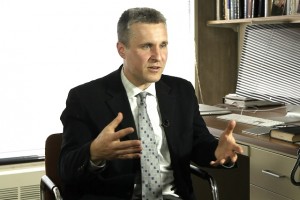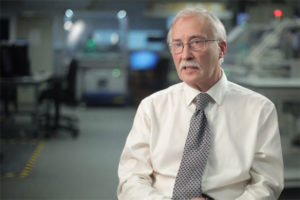James Watson: “I believe that the most impor...
One of the discoverers of the structure of DNA on cancer, biochemistry and personalized medicines
What is the suppression of phase transformation? Which theory can marry chemical kinetics to non-equilibrium thermodynamics? Professor Department of Chemical Engineering at the Massachusetts Institute of Technology Martin Z. Bazant explains what processes lead to quasi-equilibrium states of matter.
In the case of electrochemical reactions the classical model for describing the kinetics (or the reaction rate) is the Butler-Volmer equation, which is about 100 years old now and is widely used, and it fits a variety of experimental data. The Butler-Volmer equation was originally just an empirical expression that fit experimental data. And then starting in the 1950s a microscopic theory of charge transfer developed, initiated by Marcus, who then won the Nobel prize in chemistry for that work, and it was also advanced by many scientists even in Russia, for example, Levich, and Dogonadze, and Kuznetsov.
The classical theory of chemical kinetics essentially says that the reaction rate in, let’s say, the forward direction is proportional to the concentrations of the reactants. That’s the simplest assumption. But from the physics point of view I would characterize that as the mean field approximation: we know how many molecules there are, the rate should be proportional to that number of molecules. But we have to go beyond that, and start thinking in terms of activities and thermodynamic corrections. And that sort of approach has been developed in chemistry, but more can be added, and that’s something I’ve been trying to do.
What if we have very strong elastic interactions? For example, when we insert the particle it creates a huge strain, it expands the solid in one region. And that expansion then effects neighbouring regions and, hence, effects their reaction ring. And so you start to get very coupled systems, where the reaction must to be sensitive to the thermodynamic state of the material. How much entropy does it have? How many empty spaces are there in the system? When a particle wants to insert itself, is it attracted to other particles or repelled from them?
In an intercalation, or an insertion, process, if you’re inserting into a particle or through a surface that has two or more stable states, then you can get a propagation of, what I call ‘an intercalation wave’. Basically, the insertion happens always at the phase boundary that propagates the phase boundary and, so, it’s kind of a bunch of domino’s that start to fall down one by one, you fill layer by layer, you have a wave sweeping across the surface. That’s very different from the typical predictions of chemical kinetics, which would tell you that the reaction starts at the surface, inserts material uniformly, and then diffuses in.

One of the discoverers of the structure of DNA on cancer, biochemistry and personalized medicines

Chemical engineer Martin Z. Bazant on understanding dynamics at intermediate scale, "deionization shocks", and...

Biochemist Ian Wilson on individual receptiveness to drugs, pharmacokinetics, and in vitro technologies of dru...